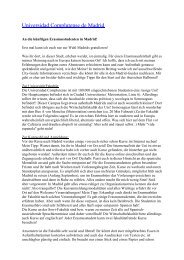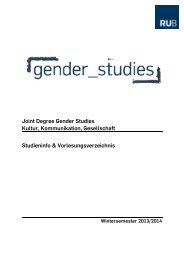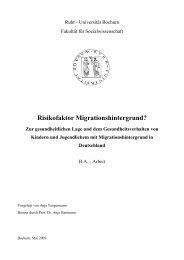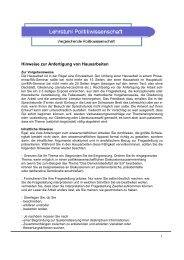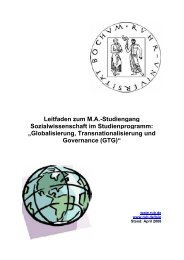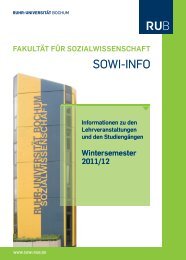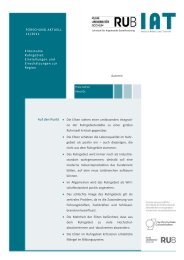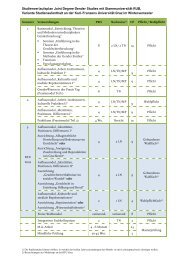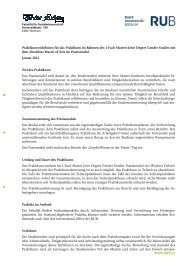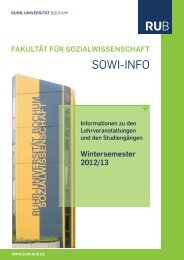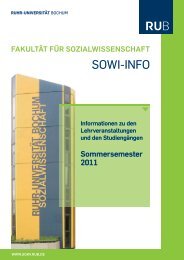View - Fakultät für Sozialwissenschaft der Ruhr-Universität Bochum
View - Fakultät für Sozialwissenschaft der Ruhr-Universität Bochum
View - Fakultät für Sozialwissenschaft der Ruhr-Universität Bochum
Create successful ePaper yourself
Turn your PDF publications into a flip-book with our unique Google optimized e-Paper software.
Wilkesmann/Rascher self-governance and slowness page 23<br />
have been with the company for a very long time work has become a routine and therefore<br />
they do not have intrinsic motivation any more. In or<strong>der</strong> to test whether the groups of<br />
employees with a period of employment from zero to one year, from one to ten years, and<br />
with more than ten years differ with respect to their intrinsic motivation, a variety analysis<br />
with Duncan test is carried out (table 3; cf. Backhaus et al. 1996: 56ff). The test reveals that<br />
the second group of employees (with a seniority of one to ten years) differs from the other<br />
groups with respect to intrinsic motivation. This group of employees has been chosen as<br />
reference variable for the regression analysis. The first two variables (sex and country) do not<br />
have a significant influence on the intrinsic motivation, but the period of employment (in this<br />
case one to ten years) does.<br />
Seniority<br />
Intrinsic<br />
sub-categories for Alpha = ,05<br />
motivation<br />
N average SD 1 2<br />
> 10 years 68 4,279 1,185 4,279<br />
0-1 year 19 4,578 1,227 4,578<br />
1 – 10 year 176 5,221 1,312 5,221<br />
F 14,175<br />
significance ,000 ,288 1,000<br />
Duncan-test: uses an harmonic average for the size of the sample = 41,0; the sizes of the groups are<br />
not identical. The harmonic average of the group size is used. Error level of type I are not guaranteed.<br />
table 3: Variety analysis with Duncan-test: seniority and intrinsic motivation<br />
Dependent variable: Dimension of intrinsic motivation<br />
Beta coefficient<br />
standard error<br />
constant (4,779)** ,622<br />
sex x -,032 ,214<br />
country y -,028 ,168<br />
period of employment z ,176** ,162<br />
task identity and feedback -,311** ,058<br />
autonomy -,087 ,104<br />
task significance and skill variety ,348** ,068<br />
R 2 ,296<br />
corrected R 2 ,278<br />
F 16,588**<br />
N 244<br />
** Significant on the level of 0,01.<br />
* Significant on the level of 0,05.<br />
x female = 0; male = 1<br />
y Germany is the Reference variable, interaction effects have been tested<br />
z Reference variable is a seniority between 1 and 10 years<br />
table 4: Multiple linear regression: intrinsic motivation<br />
As the dimension of intrinsic motivation has been operationalized only indirectly, the<br />
assumed connection is to be analysed with the help of the question presented above<br />
23




